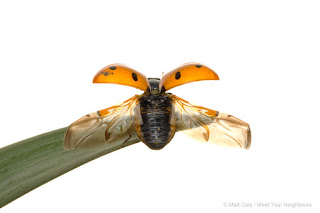To photograph them in this manner presents a number of challenges. First, I need to get in position next to a ladybird and have a reasonable degree of confidence that it is about to take-off. Second, the timing is crucial. If I release the shutter a second too early its wing cases are yet to open and I get a fairly mundane image of a ladybird sitting on a leaf. But if I'm a second too late it is in the air. If the latter happens I soon realised that it is impossible to prevent the ladybird being blurred even when exposing them purely with flash - what is needed is high speed flash which I don't have. So my only option is to photograph them as they open their wing cases and wings but before they have actually taken off. The final challenge is to get all of the key parts of the ladybird in focus, no mean feat as the depth of field is extremely shallow and the body position tends to move slightly as it opens its wings.
The technique I settled on is as follows. Take some kind of perch such as a leaf or blade or grass (I've been using a daffodil leaf) and hold it in your left hand. Encourage a ladybird onto it and hold it in direct sunshine so that the ladybird warms up. It will then often, but by no means always, walk to the top of the leaf and think about taking off. The tell-tale signs that it is thinking about taking off are that its wing cases move apart ever so slightly. If it is cold this will not happen so some sunshine is necessary here. In terms of camera gear, a short focal length macro lens is needed as this has a short working distance meaning (a) you can rest the lens on your left hand so that it and the ladybird's perch moves as one and (b) it is possible to get your diffused flash very close to the subject thereby helping with the quality of light. My lens of choice has been the Canon 60mm macro lens, a superb little lens. I opted not to use my MPE-65 as the degree of magnification is too great making the depth of field too shallow to get the plane of focus exactly in the right position. Instead, I use the 60mm lens at a little under 1x magnification and use f18 to give myself a fighting chance. I illuminate the images entirely with flash to allow me to use an aperture that small. Finally, it is necessary to hold the ladybird's perch close to some background foliage to prevent the background being black (because of the flash).
I have had a number of sessions photographing ladybirds in this way in recent weeks and have been aided by a large number of willing ladybirds and some unseasonally sunny weather. The following 2 images are probably my favourites so far.
CLICK ON IMAGES TO ENLARGE
I have also captured one or two slightly different poses that I quite like:
However, I wouldn't like the readers of this blog to think that I achieve images like those above every time :-) I have many, many images of blurred ladybirds disappearing out of frame, the one below being typical!
Finally, I have also tried to photograph ladybirds taking off in the Meet Your Neighbour style (see this post for an explanation), with the 2 below being those I like best;







very nice
ReplyDeleteThanks Dean
ReplyDeleteQuite amazing and very generous of you to share your knowledge and experience
ReplyDeleteThanks Peter
ReplyDeleteNice post Matt with accompanying shots. That's pretty much the technique I use - although I don't have flash. Have to say I even like the 'failed' blurry departure one!
ReplyDeletethanks Rachel! I must admit I do quite like the ladybird's pose on the blurred one :-)
ReplyDelete